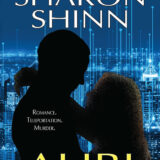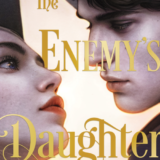
OBIR: Occasional Biased and Ignorant Reviews reflecting this reader’s opinion.

The Bloodstone – by Arlene F. Marks
Publisher: Brain Lag, Milton, Ontario, Canada, March 2024
Premise:
A typical Canadian teenager, dreaming of achieving stardom in the NHL, discovers—much to his surprise—that he is actually a shapeshifting, quasi-mortal, vampiric alien. He may have to change his career goals.
Review:
I thought I’d start by giving an “elevator pitch” for this novel, i.e. the kind of summation a desperate writer throws at a publisher during a chance meeting in an elevator, presumably during a writers festival or at a science fiction convention.
Now, I am a publisher, but I don’t publish novels, only short stories and poems, so I’ve never been the recipient of an elevator pitch. And, while I have critiqued opening pages of novels at assorted blue pencil sessions, I am what I would call, so far anyway, a near-professional author of unpublishable novels and have never yet had the opportunity to hurl an elevator pitch at an honest-to-god publisher in an honest-to-god elevator. So, one might question my ability to write anything, let alone come up with an accurate elevator pitch. Nevertheless, here goes:
I would begin my elevator pitch for “The Bloodstone” by describing it as “The Godfather meets Tom Clancy.”
This may or may not come as a considerable surprise to the readers of the previous novel in the series, not to mention to the author, Arlene F. Marks, but hear me out.
Yes, one aspect of this novel has to do with the coming of age of a typical Canadian Earthborn alien. But the novel as a whole has to do with spy/agent covert shenanigans against a backdrop of an ongoing “cold war” the average human isn’t even aware is taking place. Utilizing bits from my review of “The Earthborn,” the first novel, let me explain the nature of the war.
On the planet Rin Yeng, the Yeng inhabitants in a particular valley discover a rare mineral called “Dashkra” or “Bloodstone” exposure to which causes the locals to evolve into shapeshifters who treat those who live beyond their valley as prey. The Emperor of Rin Sheng sends his army of Yeng to wipe out the foul fiends who have taken to calling themselves Nash’terel. The latter, with the aid of super-duper science, discover a rift in space/time which opens a connection to Earth every hundred years or so. The Nash’terel flee to Earth, taking all the Bloodstones with them, leaving only dust left over from polishing the stones into gems.
However, said dust evolved the remainder of the inhabitants of Rin Yeng into Nash’terel, albeit a separate cultural grouping who really hate the original Nash’terel and want to slay them all. Plus, they’re rather keen on acquiring the human race as useful dairy cattle, so to speak.
Meanwhile the Nash’terel have done their best to blend in with human civilization disguised as ordinary human beings. One of the quirky details common to them all is that age slowly and live incredibly long lives. They can only be “Joe Smith” for twenty years before partners, co-workers and neighbours begin to wonder why they never age. So, they frequently have to disappear and start new lives lest they blow their cover.
Trouble is Yeng assassins pour out of the rift every time it opens. They are ideologically driven fanatics whose greatest pleasure is offing Nash’terel. Highly motivated, they spend every waking moment tracking down their quarry and they never give up. Worse, they can be anywhere. They are shapeshifters, after all. They can resemble any human they wish or take the place of any disposable human like your boss, your lawyer, your drug supplier, anybody. If you’re a Nash’terel, you can’t trust anybody to be what they appear to be. Not even your closest friends and relatives.
Characters move in a miasma of Philip K. Dick-level paranoia. This captures perfectly the mind-scape situational awareness of secret agent life, so often displayed in Tom Clancy novels and other thrillers of that ilk. One of the great attractions of that genre is that things can easily get worse and often do. That happens in the “The Bloodstone” quite a lot. Just when you think the characters you identify with have got a grip on things, it turns out they don’t and everybody is plunged back into peril. Much is at stake. The Nash’terel face extinction and humanity the prospect of the end of life as we know it. Plenty of motivation to go around. But what to do about the threat posed by the Yeng?
And what about “The Godfather” aspects? Literally a case of competing “families” or “clans.” The first Nash’terel settlers, most of them still alive, are the elders of generations of their descendants, all utterly loyal to their founders. However, they live their lives in utmost secrecy, not only to avoid giving themselves away to the Yeng, but also to hide their nature from humans, who tend to destroy whatever they don’t understand. That the Nash’terel originally sucked blood was definitely frowned upon by superstitious humans, thus giving rise to Vampire lore. You don’t empathise with a vampire. You kill it. That modern Nash’terel content themselves with human life essence in moderation, though sometimes, if especially hungry, with raw flesh, would not be considered an improvement. Of necessity, secrecy is an obsession.
As a result, descendants of a given founder rarely interact with other “families.” They avoid each other. This has virtue, in that if a given family is compromised, the others may escape detection. And some families are devoted to traditional views they’ve developed, assigning magical powers to the Bloodstones. After all, don’t each of the owners possess a particular power, be it the ability to manipulate air, or heat, or sound? The Yeng, having been exposed to dust but lacking actual stones, have no such special powers, apart from a common ability to shapeshift. But they possess technological weapons deadly to the Nash’terel, and are to a degree evenly matched, so still a deadly threat.
Certain Nash’terel believe the Bloodstones can be understood only through science, and once fully explained, render the Yeng easier to kill. As a result there is a religion versus science conflict built into Nash’terel society which renders cooperation among the families even more problematic. The hostility has reached the point where some individuals regard those holding the opposing view not to be wrong-headed so much as traitors.
Just to confound matters further, some Yeng liked being dropped into human society so much they largely gave up the war and settled in, reacting defensively against the Nash’terel only when they feel threatened. They, too, have built up multiple generations of Earthborn, who tend to maintain a truce-like peace with the Earthborn Nash’terel, much to the annoyance of any freshly-arrived Yeng assassins.
In short, the environment consists of all manner of vested interests whose potential for unexpected interference is capable of tripping up even the best-laid plans and schemes. Secretive clans outmanoeuvering each other below the radar in an illegal manner? “The Godfather meets Tom Clancy” seems an apt description to me.
All of the above is mere backdrop to the plot in this, the second volume of the series. What makes “The Bloodstone” unique? A disturbing trend has emerged. Instead of attempting to kill the leaders and primary warriors of the families and thus disrupt both them and the loose organizations they belong to, triads of Yeng assassins have begun to target the most vulnerable family members, the children. Why? And how can this new strategy of the enemy be stopped in its tracks?
Travis, the sixteen-year-old star player of the Rockets hockey team of Georgian Bay, Ontario, shows unusual promise. A Nash’terel/human hybrid, his burgeoning poltergeist-like skill (handy for getting the puck in the net) is of unusually high quality. Once he’s learned to shape shift and control his thirst for essence, he’ll be a formidable warrior and perhaps perform other useful roles superbly well. He may or may not be on the Yeng target list, but his inborn talent makes him a high priority convert to full Nash’terel situational awareness. Fortunately, the two “grandfathers” bringing him up—actually partners, one of whom is his Great Uncle—are ideally suited to take him to Vancouver to meet his birth parents and undergo intense training.
Despite the premise I described at the beginning of this review in order to grab your attention, Travis is not the main character. If anybody, the two “Grandfathers” are the characters most often visible on the page. The plot as it unveils is mostly experienced by them. Still, Travis is a readily accessible character. In my case, especially so, since at the same age I was wrenched from life in Toronto and hustled off to live in Vancouver, losing my friends and schoolmates to start life anew with numerous strangers in a new setting without my having any say in the matter. Easy for me to identify with his reluctant, petulant, sulking manner and refusal to be anything but miserable.
Mind you, his case is more extreme. For one thing, he is newly prone to occasional bouts of shapeshifting regarding his appendages, which far outweighs my former sense of potential pariah status due to frequent bouts of acne. And my desire to learn more about girls, especially naked nubile girls, probably doesn’t compare to his growing fangs and having unnatural urges. My urges, at least, were natural, or so I hoped (in the sense of quickly being brought to fruition. Alas, my immaturity stood in the way, but I digress).
Truth is, anybody who has ever parented a teenager, or can vividly remember what it was like being a teenager (some adults can’t), will find Travis perfectly credible and often quite amusing.
As for all the other main characters, including some of the Yeng, at first they seem notable for a given persona, often off putting or pointing to innate villainy, but gradually the reader comes to understand their background motivation and goals for the future. Even the closest of friends and/or relatives are revealed to be working emotionally at cross purposes albeit for a common cause. In short, their relationships are as confusingly dysfunctional as your average family in real life, but not enough to destroy the relationships. Like most people, somehow they muddle through.
This level of emotional realism anchors what is essentially fantasy science fiction to a bedrock of credibility and plausibility. The reader has no problem accepting the “reality” and going with the flow.
Further drawing the reader into the story is the fact that it is constructed like a mystery. Any fan of that genre will enjoy this book. All the main characters are constantly examining events in order to find enough clues to figure out exactly what is going on and how to deal with it. Many a new clue throws previous theories on their head and forces desperate on-the-spot re-evaluation to keep abreast of developments. As a consequence, many a planned spy-type shenanigan has to be dropped and replaced with something even more underhanded and/or violent.
CONCLUSION:
Personally, I found the last Tom Clancy book I read too dull to be worth reading, but I bought it at the airport to keep me busy on the plane, so I forced my way through it. Alas, it made the time go by slower.
Whereas “The Bloodstone”, which I have defined as a “Tom Clancy-ish thriller, Godfather epic, mystery novel,” in my experience was exciting and fun to read. It’s a lot more complex in plot and characterization than first appears but is so well put together the blossoming revelations ease the reader’s eyetracks and draw them further and further into the story, and perhaps more importantly, into the characters. I found myself concerned for their safety and caring what happened to them.
For someone who is most “turned on” by concept-driven fiction and typically assigns characterization a lesser role, that’s quite a confession. I hope it convinces you to read “The Bloodstone.” Believe me, if you like to enjoy reading and like to be entertained while you read, “The Bloodstone” is well worth reading. It’s loads of fun.
Find it at: < The Bloodstone >










